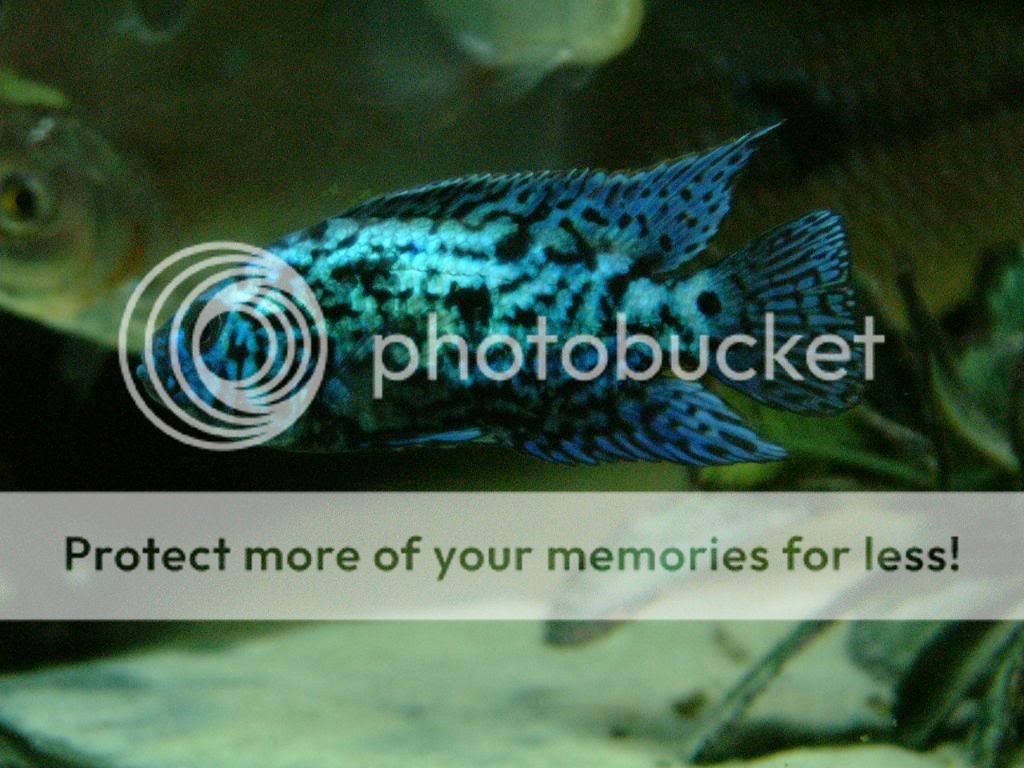blakwidoe
Fish Crazy
Common name:Jack dempsy
Scientific name: Rocio Octofasciatum
Family: Cichlidae
Origin: Central America
Max Size: 9"
Temp:72-78 F.
Care: The Dempsey is definitely not for the community tank. While they may be kept with other fish of similar size, the Dempsey is best kept in a species tank. Their aggressiveness should never be underestimated, and increases largely during spawning, a minimum tank size of 45g is needed for a single fish. The Dempsey tank should have a thick layer of gravel, 4-5", with rocks of various sizes and caves for hiding places. Due to the digging nature of this fish, any plants which you might have in the tank should be well rooted, and do not be surprised if they are torn up every once in a while. Pre-soaked clay flower pots make for wonderful hiding places, as well as a good place for them to lay their eggs. These fish are from the area of Central America, they should have mildly hard water, with a neutral to slightly acidic pH. Although water conditions are not as strict as with other fish, they will be happier and healthier with the right water chemistry.
Feeding: Omnivorous
This fish is not usually very picky about what it eats, although it may take some time for them to adjust to a different food they are changing from a consistent diet. It is best to vary their diet, alternating between pellets, guppies, shrimp, lettuce, earthworms, snails, and most other crustaceans. This will provide them with the nutrients they need to become healthy, colorful adults.
Breeding:
Jack Dempseys spawn in the usual Cichlid fashion, the female laying her eggs on carefully cleaned rocks usually a smooth slate or clay pot. The adults are model parents and both guard and care for the young.
Sexing the Jack Dempsey becomes increasingly difficult the younger the fish is. The most obvious ways to tell are with the male having longer and more pointed dorsal and anal fins, a longer body, and less blue-green coloration on the gill plate. The body of the female is more squat than that of the male, and the dorsal and anal fins are shorter as well.
Scientific name: Rocio Octofasciatum
Family: Cichlidae
Origin: Central America
Max Size: 9"
Temp:72-78 F.
Care: The Dempsey is definitely not for the community tank. While they may be kept with other fish of similar size, the Dempsey is best kept in a species tank. Their aggressiveness should never be underestimated, and increases largely during spawning, a minimum tank size of 45g is needed for a single fish. The Dempsey tank should have a thick layer of gravel, 4-5", with rocks of various sizes and caves for hiding places. Due to the digging nature of this fish, any plants which you might have in the tank should be well rooted, and do not be surprised if they are torn up every once in a while. Pre-soaked clay flower pots make for wonderful hiding places, as well as a good place for them to lay their eggs. These fish are from the area of Central America, they should have mildly hard water, with a neutral to slightly acidic pH. Although water conditions are not as strict as with other fish, they will be happier and healthier with the right water chemistry.
Feeding: Omnivorous
This fish is not usually very picky about what it eats, although it may take some time for them to adjust to a different food they are changing from a consistent diet. It is best to vary their diet, alternating between pellets, guppies, shrimp, lettuce, earthworms, snails, and most other crustaceans. This will provide them with the nutrients they need to become healthy, colorful adults.
Breeding:
Jack Dempseys spawn in the usual Cichlid fashion, the female laying her eggs on carefully cleaned rocks usually a smooth slate or clay pot. The adults are model parents and both guard and care for the young.
Sexing the Jack Dempsey becomes increasingly difficult the younger the fish is. The most obvious ways to tell are with the male having longer and more pointed dorsal and anal fins, a longer body, and less blue-green coloration on the gill plate. The body of the female is more squat than that of the male, and the dorsal and anal fins are shorter as well.






